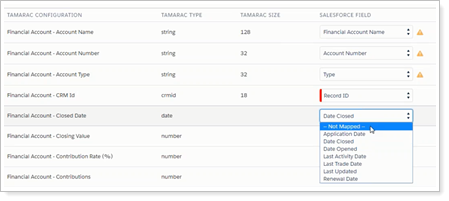 Back
Back
 Back Back |
Home > Tamarac Reporting > Integrations > CRM Integrations > Salesforce Integration > Install and Configure Tamarac App > Understanding Mapping in the Salesforce Integration
|
Understanding Mapping in the Salesforce Integration
|
Mapping Behavior and Requirements for Various Salesforce Installations |
Mapping links a field in Tamarac Reporting with the same field in Salesforce. It allows you to use your existing customized Salesforce objects to view Tamarac data by telling the two systems where each piece of data belongs.
You can map the following Salesforce objects:
Contacts (called clients in Tamarac Reporting)
Accounts (called Households in Tamarac Reporting)
Tasks (generated based on actions taken in Tamarac Reporting)
Financial Accounts (called accounts in Tamarac Reporting)

By default, all supported fields for each object are automatically mapped if you are using Classic Sales Cloud or Sales Cloud with Lightning Experience and the Tamarac Financial Account object. However, you can adjust the mapping to integrate with any fields you choose.
For steps on how to configure mapping between Salesforce and Tamarac Reporting, see Workflow: Configure Mapping.
Note that the Configure Mapping workflow is step three of five in the overall onboarding workflow if you are using Classic Sales Cloud or Sales Cloud with Lightning Experience and the Tamarac Financial Account object. For the overall workflow, see Workflow: Set up Salesforce/Tamarac Integration for Sales Cloud Users.
In order to pass information between Tamarac Reporting and Salesforce, fields in each area of integration must be mapped.
Use the Manage Mapping tab in Salesforce to determine which objects should integrate between Tamarac Reporting and Salesforce and which should be maintained separately.
The following table provides details of sync direction and frequency once fields are mapped.
| Tamarac Reporting | Directionality | Salesforce | Sync Frequency |
|---|---|---|---|
| Client |

|
Contact | Immediately upon change being made |
| Household |

|
Account | Immediately upon change being made |
| Account |

|
Financial Account | Upon sync with portfolio accounting system |
| Events |

|
Tasks | Immediately upon change being made |
| Single Sign-On |

|
Single Sign-On | One-click login to Tamarac Reporting from Salesforce |
When mapping, keep the following in mind:
Any individual object can only be mapped once. After an object has been mapped, it will no longer be available from the mapping list.
Fields marked with a red bar must be mapped.

Mapped fields must match type. For example, a Date field must map to another Date field, not a Text field.
Deleting an object in Mapping will remove all default mapping settings for that object's fields, even if the object is subsequently added back to Mapping.
When mapping fields, you may notice some warning icons next to the Salesforce field. This indicates that the Tamarac field size and the Salesforce field sizes differ. If data longer than the Tamarac field size is entered, it may be cut off in Tamarac Reporting.

If you are creating a custom field to map to a Tamarac field, ensure that the field sizes match.
Refer to the following table for integration behavior and mapping requirements for Financial Accounts.
| If You Use... | Field Mapping Status | Details |
|---|---|---|
| Classic Sales Cloud or Sales Cloud with Lightning Experience | Tamarac Reporting provides a default financial accounts object with default fields already mapped. |
See Map Default Financial Accounts/Accounts in Sales Cloud in Configure Financial Account/Account Mapping. |
| Your own custom Financial Account object | You will manually map Tamarac Reporting integration fields so you can see Tamarac data in your existing Financial Accounts object. |
See Map to a Custom Financial Account Object in Configure Financial Account/Account Mapping. |
| Salesforce Financial Services Cloud | Some Tamarac Reporting fields will map by default; however, you will manually map some Tamarac Reporting fields so you can Tamarac see data in your existing Financial Accounts object. | See Manually Map to a Financial Services Cloud Financial Account Object in Configure Financial Account/Account Mapping. |